✉ shreeconsultancyjsb@gmail.com ✆ Ph. No.: +91 78781-47589 , +91 97828-06464

How to Choose the Right Study Abroad Program for Your Major
Not sure how to choose the right study abroad program for your major? This complete guide breaks down key steps, from curriculum and country to faculty and ROI.
Introduction – Why Program-Major Fit Matters
Choosing the right study abroad program is one of the most important academic decisions you’ll make. While it’s easy to be swayed by location or rankings alone, your major should guide your final choice. The program you select should align with your career aspirations, skill development, and subject interests. Let’s explore how to make an informed, confident decision.
Step 1: Understand Your Academic and Career Goals
Before looking at programs, ask yourself:
Do I want to go into research, corporate jobs, or entrepreneurship?
What are the top three things I want to learn during my degree?
Do I prefer theoretical or practical learning?
Define:
Short-term goals: What job or skill do you want immediately after graduation?
Long-term goals: Where do you want to be in 5–10 years?
This clarity will help filter the best programs for your major.
Step 2: Research Program Accreditation and University Reputation
Not all degrees are created equal. A well-accredited and reputable program holds more value globally.
Check:
Is the university nationally accredited?
Is the program recognized by international bodies in your field?
How does it rank globally and in subject-specific rankings?
For example, QS World University Rankings or Times Higher Education offer major-wise rankings—an engineering school may rank lower overall but top 10 in its discipline.
Step 3: Evaluate Course Curriculum and Specializations
Don’t rely only on the program title—dig into the curriculum.
Consider:
Are the core courses aligned with your interests?
Are there elective modules that support your niche?
Does the program require a capstone project or thesis?
Look at the structure across all semesters. Compare similar programs across 2–3 universities.
Step 4: Check Faculty and Research Opportunities
The right professors can elevate your learning experience significantly.
Look into:
Faculty profiles and their published research
Opportunities to assist in labs or academic research
Funding availability for undergraduate/postgraduate projects
If you’re pursuing a STEM or research-heavy field, this is especially critical.
Step 5: Choose a Country That Supports Your Major
Some countries specialize in specific disciplines:
Your career pathway and work permit options post-graduation should also influence your choice.
Step 6: Consider Internship and Industry Linkages
Internships can turn into full-time offers, making them a vital component.
Ask:
Does the program have mandatory internships?
Are there partnerships with companies or startups?
Are students allowed to work during the program?
Countries like Germany, Canada, and the UK often integrate internships into degree programs.
Step 7: Review Admission Requirements and Language Needs
Ensure you're eligible and ready to meet all entry criteria.
Common Requirements:
GPA or academic score minimums
Standardized tests: IELTS/TOEFL, GRE, GMAT
SOP, LORs, and Resume
Portfolio (for arts and design majors)
Also confirm the language of instruction—many European programs are offered in English even if the local language is different.
Step 8: Assess Cost, Scholarships, and ROI
Choosing the right program also means making a financially wise decision.
Evaluate:
Annual tuition fees
Cost of living in that city/country
Availability of scholarships or grants
Post-study earning potential
Always think in terms of ROI (Return on Investment).
Step 9: Talk to Program Alumni and Advisors
First-hand insights can give you clarity you won’t find in brochures.
Connect with past students on LinkedIn
Ask about job placements, challenges, and pros/cons
Join university webinars and forums to engage with current students
Step 10: Explore Student Life and Support Services
Academics aren’t everything—your well-being and social life matter too.
Explore:
Availability of student clubs and communities
Counseling and academic support
Events, workshops, and field trips
Housing, transportation, and health services
Happy students are often successful students.
FAQs – Choosing the Best Study Abroad Program for Your Major
Q1: Should I prioritize rankings or specialization?
Focus on specialization. A mid-ranked university with a strong major program can be more beneficial than a top university with a weak one.
Q2: Can I switch majors while studying abroad?
In many universities, yes—but it’s not always easy. Clarify this before applying.
Q3: Is it okay to choose a new major I haven’t studied before?
For postgraduate programs, yes—if your background supports it and you justify it in your SOP.
Q4: What if my chosen country has limited job options?
Prioritize education first, then research post-study work visa options.
Q5: How do I know if a program is internationally recognized?
Look for accreditation and affiliations with international academic bodies.
Q6: Can I apply for multiple programs across countries?
Absolutely. Apply to 3–5 programs to increase your chances and flexibility.


